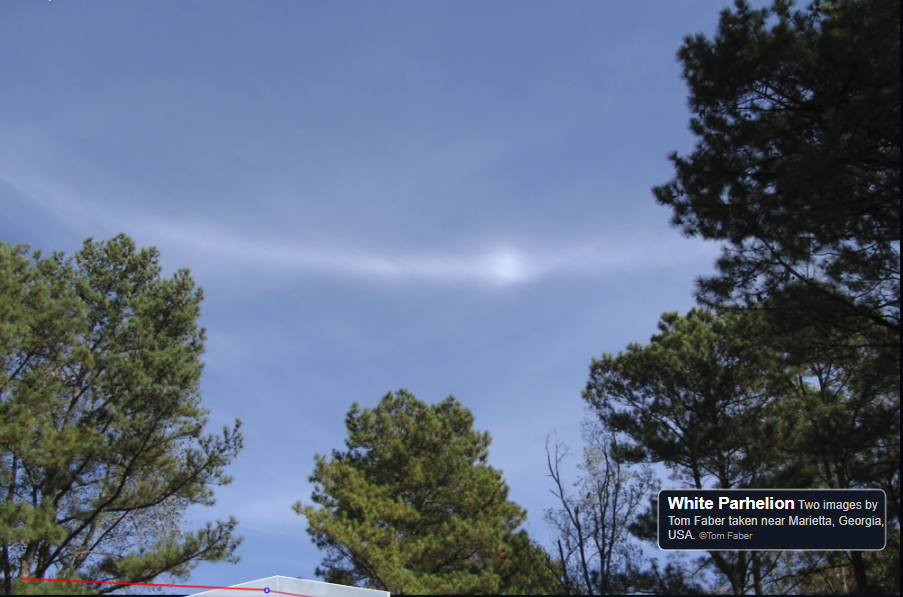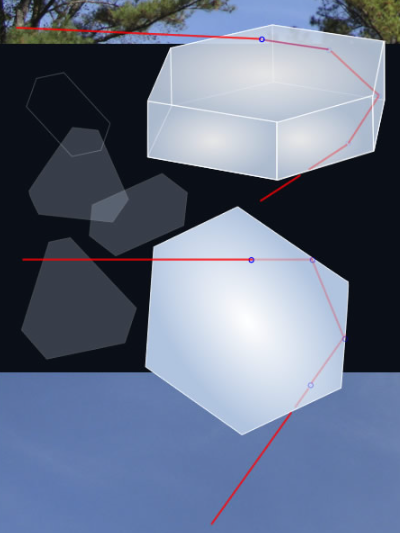OPOD - White Sundog
OPOD - White Sundog: A Rare Atmospheric Phenomenon
Have you ever witnessed a white sundog? This captivating atmospheric optics phenomenon, also known as a parhelion, extends further from the sun than the more commonly observed sundogs at approximately 22°. While the 22° sundogs are familiar to many, parhelia have been reported at various distances from the sun, including 44°, 90°, 120°, and even 180°. However, it is worth noting that parhelia at 90° are unlikely to exist, and the brightness opposite the sun at 180° is caused by the intersection of two or more halo arcs.
Tom Faber, a keen observer of atmospheric optics, captured stunning images of a parhelion at a distance of 120° from the sun near Marietta, Georgia, USA. These images provide valuable insights into the formation of this rare phenomenon.
The formation of a parhelion involves rays of light entering the top faces of hexagonal plate ice crystals and undergoing two internal reflections from the vertical side faces before exiting through the lower face. This tortuous path of rays contributes to the complex nature of parhelia. Additionally, other similarly convoluted ray paths play a role in their formation.
One fascinating aspect of parhelia is that the entrance and exit rays make the same angle with the large flat crystal faces. This characteristic cancels out the color separation, known as dispersion, that occurs during the first refraction. Consequently, parhelia appear colorless, distinguishing them from other atmospheric optical phenomena.
The intricate ray paths that give rise to parhelia are most commonly observed in thick plates or those with non-regular hexagonal shapes and a more triangular aspect. While non-regular hexagons frequently occur in ice crystals, the angles between their faces remain fixed at 90° and 120°. This fixed angle configuration contributes to the formation of parhelia.
It is essential to keep an eye out for 120° parhelia when observing a bright "22°" sundog. Although rare, these parhelia can sometimes be overlooked, especially when they are projected against white hazy cirrus clouds. Their subtle presence adds an extra layer of intrigue to the atmospheric display.
In conclusion, the white sundog, or parhelion, is a remarkable atmospheric optics phenomenon that extends beyond the familiar sundogs at approximately 22° from the sun. Tom Faber's images near Marietta, Georgia, provide valuable insights into the formation of parhelia. The complex ray paths involved in their creation, as well as the cancellation of dispersion, contribute to the colorless appearance of parhelia. By keeping an eye out for 120° parhelia when observing a bright "22°" sundog, one may have the opportunity to witness this rare and captivating atmospheric spectacle.

White Parhelion Two images by Tom Faber taken near Marietta, Georgia, USA. ©Tom Faber

Parhelia or sundogs extend further from the sun than the familiar ones at around 22°. Others have been reported along the parhelic circle at 44, 90, 120 and 180 degrees from the sun. Those at 90° likely do not exist and brightness opposite the sun at 180° is due to the intersection of two or more halo arcs.
Tom's parhelion is 120° distant. It can be formed by rays entering the top faces of hexagonal plate ice crystals and being internally reflected twice from vertical side faces before leaving through the lower face. Other similarly tortuous rays paths contribute also.
The entrance and exit rays make the same angle to the large flat crystal faces. The colour separation, dispersion, at the first refraction is therefore cancelled by that at the second. There is no net dispersion and the parhelion is colourless
The complex ray paths are best favoured in thick plates or those that are non regular hexagons and having a more triangular aspect. Non regular hexagons frequently occur but the angles between their faces remain fixed at 90 and 120°.
Always look for 120° parhelia when there is a bright '22°' sundog. 120° parhelia are rare but can also be overlooked when projected against white hazy cirrus.

Note: this article has been automatically converted from the old site and may not appear as intended. You can find the original article here.
Reference Atmospheric Optics
If you use any of the definitions, information, or data presented on Atmospheric Optics, please copy the link or reference below to properly credit us as the reference source. Thank you!
-
<a href="https://atoptics.co.uk/blog/opod-white-sundog/">OPOD - White Sundog</a>
-
"OPOD - White Sundog". Atmospheric Optics. Accessed on November 26, 2024. https://atoptics.co.uk/blog/opod-white-sundog/.
-
"OPOD - White Sundog". Atmospheric Optics, https://atoptics.co.uk/blog/opod-white-sundog/. Accessed 26 November, 2024
-
OPOD - White Sundog. Atmospheric Optics. Retrieved from https://atoptics.co.uk/blog/opod-white-sundog/.